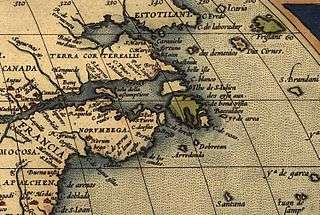Norumbega

Norumbega or Nurembega is a legendary settlement in northeastern North America which appeared on many early maps from the 1500s until American colonization.[1]
Jean Allefonsce in 1542 reported that he had coasted south from Newfoundland and had discovered a great river. It often appeared on subsequent European maps of North America, lying south of Acadia in what is now New England. Bangor embraced the legend in the nineteenth century, naming their municipal hall "Norumbega Hall". In 1886 inventor Joseph Barker Stearns built a mansion named "Norumbega Castle", which still stands on US Route 1 in Camden, Maine, overlooking Penobscot Bay.[2]
In the late 19th century, Eben Norton Horsford linked the name and legend of Norumbega to supposed Norse settlements on the Charles River, and built the Norumbega Tower at the confluence of Stony Brook and the Charles in Weston, Massachusetts, where he believed Fort Norumbega was located. In honor of Horsford's generous donations to Wellesley College, a building named Norumbega Hall was dedicated in 1886 and celebrated by a poem by John Greenleaf Whittier.[3]
The word "Norumbega" was originally spelled Oranbega in Giovanni da Verrazzano's 1529 map of America, and the word is believed to derive from one of the Algonquian languages spoken in New England. It may mean "quiet place between the rapids" or "quiet stretch of water".[4]
References and notes
- ↑ "Did Leif Erikson once live in Cambridge, Massachusetts?". The Straight Dope. Retrieved 2008-08-09.
- ↑ Schweitzer, Sarah (January 28, 2007). "Camden inn maintains grand old aspirations". Boston Globe. Retrieved 2015-01-28.
- ↑ Greenleaf, John (1894). The writings of John Greenleaf Whittier. 4. Houghton, Mifflin and company.
- ↑ Baker, Emerson W. (1994). American Beginnings: Exploration, Culture, and Cartography in the Land of Norumbega. University of Nebraska Press. p. 87. ISBN 0803245548. Retrieved 2015-01-28.
Further reading
- DeCosta, B.F. 1890. Ancient Norumbega, or the voyages of Simon Ferdinando and John Walker to the Penobscot River, 1579-1580. Joel Munsell's Sons, Albany, NY
- R. H. Ramsay, 1972. No Longer on the Map, Viking Books
- Baker, Emerson W., Churchill, Edwin A., D'Abate, Richard S., Jones, Kristine L., Konrad, Victor A. and Prins, Harald E.L., editors, 1994. American beginnings: Exploration, culture, and cartography in the land of Norumbega (University of Nebraska Press)